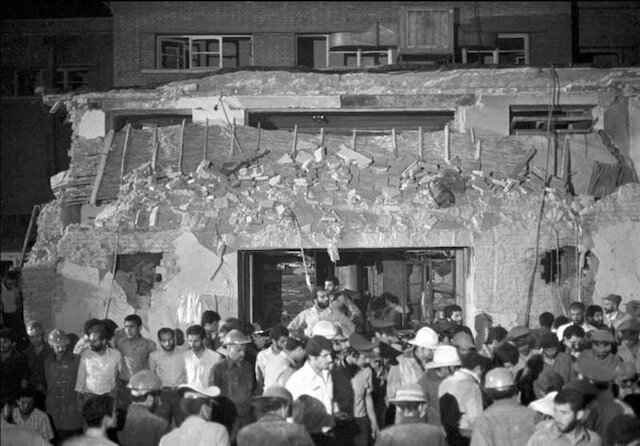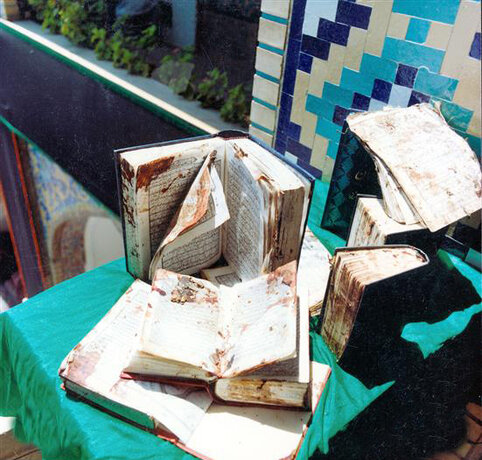It would not be an exaggeration to say that the quality and quantity of terrorist attacks carried out against Iran after the Islamic Revolution have been unprecedented in any other revolution in the world. The purpose of these terrorist attacks was to create fear in the hearts of the people, to take revenge on the people for their Revolution, and to inflict a blow to the ideological masterminds of the Islamic Revolution and the Islamic Republic.
Terrorism is a familiar word for the Iranian nation. After the victory of the Islamic Revolution in Iran and the defeat of America’s expansionist plans in the country, the U.S. gave a green light to Saddam Hussein to wage a war against Iran. Another significant development that occurred at the same time was the initiation of terrorist attacks carried out against government officials and the people.
Taking revenge on the people
The victory of the Islamic Revolution was so unexpected to many Western analysts and politicians that they could not even properly understand and predict all of its dimensions. The day after the victory of the Islamic Revolution in Iran, a wave of domestic and foreign opposition and interference started to try to undermine it. Terrorist attacks are one of the tools that have been employed by domestic and foreign enemies from the beginning to inflict a blow to the Islamic Revolution. From this perspective, terrorist attacks can be considered to be the oldest and most widely used tool they have used for eliminating opponents.
17,000 victims of assassination
The opponents of the Islamic Revolution in Iran can be categorized into three groups: the Marxist movements (most importantly, the Tudeh Party), nationalist movements (chief among them being the Freedom Movement) and other movements of a mixed nature (the MEK and the Forqan Group being the most important among them). Historical facts reveal that the vast majority of the assassinations at the beginning of the Revolution were carried out by the Munafiqeen (MEK) and the Forqan Group.
The assassination of Valiollah Gharani, the first Chief-of-Staff of the Iranian Army, on April 23, 1979; the assassination of Ayatollah Motahhari, the President of the Council of the Islamic Revolution and one of the masterminds of the Islamic Revolution, on May 1, 1979; the failed assassination attempt on Hojjatoleslam Hashemi Rafsanjani on May 25, 1979; the assassination of Haj Mehdi Araghi on August 13, 1979; the assassination of Ayatollah Qazi Tabatabai on November 2, 1979; the assassination of Ayatollah Mofatteh on December 18, 1979; the failed assassination attempt on Ayatollah Khamenei on June 27, 1981; the bombing of the Islamic Republic Party’s headquarters and the martyrdom of Shahid Beheshti and 72 of the companions of Imam Khomeini on June 28, 1981; the assassination of Hojjatoleslam Haqani on June 29, 1981; the bombing of the Prime Minister’s office and the assassination of Shahid Rajai and Shahid Bahonar on August 30, 1981; the assassination of Ayatollah Qodusi on September 05, 1981; the assassination of Ayatollah Madani on September 11, 1981; the assassination of Hojjatoleslam Hasheminejad on September 29, 1981; the assassination of Ayatollah Dastgheib on December 11, 1981; the assassination of Ayatollah Saduqi on July 2, 1982; and the assassination of Ayatollah Ashrafi Esfahani on October 15, 1982 are some of the most high-profile terrorist attacks that were carried out by the two grouplets during the early years after the victory of the Islamic Revolution. Apart from these assassinations, more than 17,000 ordinary citizens were also targeted by these terrorist groups. The terrorist attacks came to a head in the summer of 1981 following the bombings of the headquarters of the Islamic Republic Party and the Prime Minister’s office, which resulted in the martyrdom of many senior revolutionary personages as well as a number of high-ranking government officials. Of course, the terrorist attacks did not stop. For example, Asadollah Lajevardi was assassinated on September 1, 1998 and Lieutenant General Sayyad Shirazi was assassinated on April 10, 1999.

The bombing of Imam Ridha’s (pbuh) shrine was one of the most savage attacks. This terrorist attack resulted in the martyrdom of 27 people, and 300 other people were wounded. At 14:26 local time on June 20, 1984, on a Monday that coincided with mourning ceremonies for Ashura, the sound of a deafening explosion echoed inside the shrine at a time when the number of people who had gathered to mourn for Imam Hussein (pbuh) had reached its peak. In that attack, hundreds of children, women and men were killed or injured.
One of the eyewitnesses to this tragedy, Naeemabdi, said, “It was very painful to see the hands and legs that had been severed, particularly those of the children, and I lost my control. The attendants of the shrine who were present were crying and wailing so hard that it was as if their own children had been killed in front of their eyes.”

Naeemabadi also said, “They had planted the bomb next to the tomb, and the explosion left a hole in the ground, which was approximately 80 centimeters in diameter and 7 to 8 centimeters deep.”


Terrorist attacks to restrain the Revolution
The main questions that arise are: What was the purpose of these terrorist attacks? What were the goals that the opponents and enemies were pursuing in carrying out these terrorist attacks? Why do the enemies of Iran use this tool to inflict a blow on the Islamic Revolution?
It appears the most important factor that has motivated these attacks is their endeavor to restrain the Islamic Republic and the Islamic Revolution. The enemies of the Revolution are fully aware that if they fail to stop the Islamic Revolution, it will not be long before it is imitated in the entire world of Islam and even in all independent countries throughout the world. Therefore, they try to stop and disrupt its course in some way. For this reason, the Leader of the Revolution said in his speech on June 3 this year in Imam Khomeini's (r.a.) shrine that terrorist attacks are one of the methods the enemies use to create difficulties for the Islamic Revolution. He added, “One of the methods is stimulating and creating terrorist groups. They did this in Iraq. They did this in Afghanistan. They did this in certain Arab countries of the region. They did the same thing in our country as well. They create terrorist groups and assassinate certain individuals. They targeted scientists in our country. They targeted and martyred nuclear energy specialists. Before that, they targeted other people, including some of the political elite, cultural elite, scientific figures and religious personages. These terrorists have increased under U.S. protection, and some of them have been acknowledged and accepted by the Americans for the services they rendered to America. Today, the Munafiqeen are in the arms of America. They participate in various meetings of U.S. Congressional committees. The same MEK elements who killed ordinary people, prominent figures, religious scholars, scientists and politicians in Iran, the same elements who were responsible for the bombings here – today, they are with the Americans.”![]()
Terrorist attacks: a shift from politicians to scientists
From the beginning of the year 2010 to the beginning of the year 2012, the nature and orientation of the terrorist attacks changed. The enemies, who had previously been pursuing “political assassinations” with the aim of eliminating high-ranking politicians in the Islamic Republic, shifted their focus to the “assassination of scientists” during this period and martyred several Iranian nuclear scientists.
In the fall of the year 2010 and less than one month before the assassination attempts made on Dr. Majid Shahriari and Dr. Fereidon Abbasi, John Sawers (Head of the British spy agency MI6) stated in a press conference that intelligence and security operations were underway to stop Iran’s nuclear program. He openly declared, "stopping nuclear proliferation cannot be addressed with just conventional diplomacy. We need to continue intelligence operations against Iran."
After the assassination of Dr. Alimohammadi and Dr. Majid Shahriari, two other nuclear scientists in our country – namely, Darioush Rezaeinejad and Mostafa Ahmadi Roshan – were also targeted in the terrorist attacks carried out by groups affiliated with the West, and these scientists were martyred.
But the important question in this regard is, “Why did the terrorist attacks against Iran shift to the assassination of scientists? What was the reason behind this shift?”
The primary goal of the hostile groups – led by the Domineering Powers – is to restrain the Islamic Revolution in whatever way possible. Therefore, they try to eliminate anything that helps the Islamic Revolution move forward and become a role model. After the accelerated progress of the country on the path of producing knowledge, the Domineering Powers realized that the driving forces behind Iran’s progress at the present time are science and technology. The Leader of the Islamic Revolution has repeatedly stressed this point by saying, “The material progress of the country primarily depends on two factors: one is science and the other is production. In the absence of science, production will be hindered. It is the science that will help the country move forward.”
Therefore, the assassination of nuclear scientists could thwart the country’s efforts to produce nuclear science on the one hand; and on the other hand, it could instill fear in the hearts of tens of thousands of faithful, revolutionary youth who were engaged in struggling on the path for Iran’s scientific progress. Of course, this was an error in calculation on their part. These assassinations further motivated faithful, revolutionary youth to gravitate toward continuing their education in fields related to nuclear science and technology. As acknowledged by prestigious international organizations, the result was that Iran’s rate of scientific progress became 13 times the average international rate of scientific progress.
Undoubtedly, the most important terrorist action perpetrated by the US government against the Islamic Republic of Iran has been the assassination of General Soleimani, the Commander of the Quds Force of the Islamic Revolution Guards Corps, in Iraq. General Soleimani was targeted, on US President’s order on the soil of a third-party country, as an official and senior representative of the Islamic Republic of Iran and while he enjoyed customary international immunity.
Imam Khomeini's description of such numerous terrorist acts against Iran
In response to the assassinations, Imam Khomeini (r.a.) said the attempts showed an absence of rationality in the enemies’ confrontations with the Islamic Revolution. He said, “The fact that you assassinate our intellectuals in the dark of the night shows your frustration. You are devoid of rationality. If you were rational, you would talk and discuss. However, you are devoid of rationality. Your rationality is to assassinate. The logic of Islam rejects assassinations. Islam is rational.”

Comment